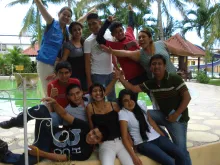During two days, we worked with 170 adolescents (from ages 13 to 18; from rural and urban areas; indigenous and non-indigenous; female and male) using innovative, playful and creative methodologies in identifying the main issues that concern them in their family environment, at school and at the community level.
Guatemala City, Guatemala: Guatemala is a young country. According to data provided by the National Statistical Institute, one fourth of the Guatemalan population is younger than 18 years old and one half is between 10 to 30 years of age. Most Guatemalan adolescents live in rural areas, and belonging to one of the ethnic indigenous groups makes them even more vulnerable given the discriminatory practices still existing in the country.
Time to take action, said UNICEF Guatemala in 2010 and build Adolescent Development, focusing on this age group of the country.
Given that few statistics about the situation of adolescents existed in the country, and given that we wanted to know what really moves their lives, together -- with the youth association Paz Joven (Peace is Young) -- we organized four workshops in different areas. What we wanted to know was, what are the main problems they struggle with? What are their dreams and plans? How do they think they can solve their problems?
During two days, we worked with 170 adolescents (from ages 13 to 18; from rural and urban areas; indigenous and non-indigenous; female and male) using innovative, playful and creative methodologies in identifying the main issues that concern them in their family environment, at school and at the community level.
The outcome of the four regional workshops was presented at a national meeting. And together, they identified the following issues:
- In the family, violence seems to be an omnipresent issue closely related to alcoholism and the social phenomenon of machismo (a type of overreaching manhood).
- The lack of communication was discussed as a source as well as a consequence of the violence. The dialogue showed that failing communication has an impact on their self-esteem.
- The lack of education in sexual and reproductive health has the severe consequence of child pregnancies and HIV.
- In school, the main concerns are the lack of access to public educational institutions and the low percentage of gross domestic product (GDP) assigned to education. In middle school, one of every three adolescents has access to and finishes middle school. Twenty per cent have access to high school education and only 0.27 per cent have access to university education.
- At the community level, the lack of job opportunities and low economic resources are the most cited difficulties. Discussing this issue, once again, led to educational issues and lack of public policy to strengthen the alternatives for adolescent job seekers.
This national agenda of adolescents in Guatemala is a useful tool in my daily work to prioritize the projects and initiatives we support, to carry out an effective advocacy for adolescents and to strengthen their own capacity to take political action.
Moreover, it has been a meaningful experience to learn from adolescents through a process of conversation in terms of what their needs and wishes are. For example, José Luis, a 14 year-old, wakes up every morning at 4 am to help a farmer milk his cows before he goes to school. He needs the money to support his family and wants to save a part of it to pay for his education in order to make his wish come true: to be a cook.

